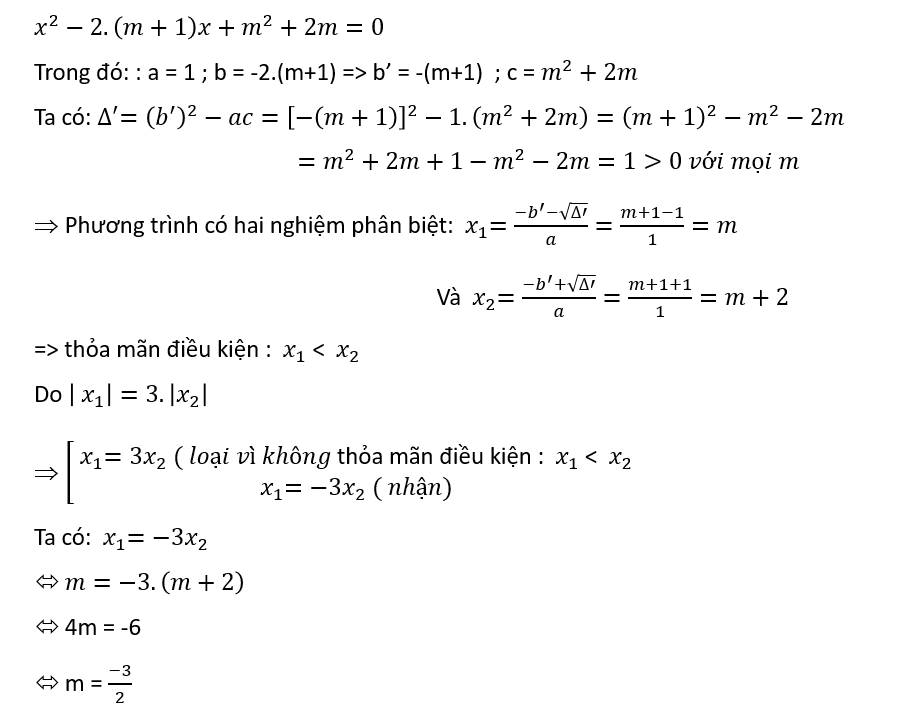Hãy nhập câu hỏi của bạn vào đây, nếu là tài khoản VIP, bạn sẽ được ưu tiên trả lời.

\(\Delta=\left(2m+1\right)^2-4\left(m^2+m-2\right)=9>0;\forall m\)
Phương trình luôn có 2 nghiệm pb với mọi m
Theo hệ thức Viet: \(\left\{{}\begin{matrix}x_1+x_2=2m+1\\x_1x_2=m^2+m-2\end{matrix}\right.\)
\(x_1\left(x_1-2x_2\right)+x_2\left(x_2-2x_1\right)=9\)
\(\Leftrightarrow x_1^2+x_2^2-4x_1x_2=9\)
\(\Leftrightarrow\left(x_1+x_2\right)^2-6x_1x_2=9\)
\(\Leftrightarrow\left(2m+1\right)^2-6\left(m^2+m-4\right)=9\)
\(\Leftrightarrow2m^2+2m-4=0\)
\(\Rightarrow\left[{}\begin{matrix}m=1\\m=-2\end{matrix}\right.\)

a)PT có 2 nghiệm phân biệt
`<=>Delta>0`
`<=>(2m+3)^2+4(2m+4)>0`
`<=>4m^2+12m+9+8m+16>0`
`<=>4m^2+20m+25>0`
`<=>(2m+5)^2>0`
`<=>m ne -5/2`
b)Áp dụng vi-ét:
$\begin{cases}x_1+x_2=2m+3\\x_1.x_2=-2m-4\\\end{cases}$
`|x_1|+|x_2|=5`
`<=>x_1^2+x_2^2+2|x_1.x_2|=25`
`<=>(x_1+x_2)^2+2(|x_1.x_2|-x_1.x_2)=25`
`<=>(2m+3)^2+2[|-2m-4|-(-2m-4)]=25`
Với `-2m-4>=0<=>m<=-2`
`=>pt<=>(2m+3)^2-25=0`
`<=>(2m-2)(2m+8)=0`
`<=>(m-1)(m+4)=0`
`<=>` $\left[ \begin{array}{l}x=1\\x=-4\end{array} \right.$
`-2m-4<=0=>m>=-2=>|-2m-4|=2m+4`
`<=>4m^2+12m+9+8m+16=25`
`<=>4m^2+20m=0`
`<=>m^2+5m=0`
`<=>` \left[ \begin{array}{l}x=0\\x=-5\end{array} \right.$
Vậy `m in {0,1,-4,-5}`

a) Ta có: \(\Delta=\left(-4\right)^2-4\cdot1\cdot\left(2m-3\right)=16-4\left(2m-3\right)\)
\(\Leftrightarrow\Delta=16-8m+12=-8m+28\)
Để phương trình có hai nghiệm x1;x2 phân biệt thì \(-8m+28>0\)
\(\Leftrightarrow-8m>-28\)
hay \(m< \dfrac{7}{2}\)
Với \(m< \dfrac{7}{2}\) thì phương trình có hai nghiệm phân biệt x1;x2
nên Áp dụng hệ thức Viet, ta có:
\(\left\{{}\begin{matrix}x_1+x_2=\dfrac{-\left(-4\right)}{1}=4\\x_1\cdot x_2=\dfrac{2m-3}{1}=2m-3\end{matrix}\right.\)
Để phương trình có hai nghiệm x1,x2 phân biệt thỏa mãn tổng 2 nghiệm và tích hai nghiệm là hai số đối nhau thì
\(\left\{{}\begin{matrix}m< \dfrac{7}{2}\\4+2m-3=0\end{matrix}\right.\Leftrightarrow\left\{{}\begin{matrix}m< \dfrac{7}{2}\\2m+1=0\end{matrix}\right.\)
\(\Leftrightarrow\left\{{}\begin{matrix}m< \dfrac{7}{2}\\2m=-1\end{matrix}\right.\Leftrightarrow\left\{{}\begin{matrix}m< \dfrac{7}{2}\\m=-\dfrac{1}{2}\end{matrix}\right.\Leftrightarrow m=-\dfrac{1}{2}\)
Vậy: Khi \(m=-\dfrac{1}{2}\) thì phương trình có hai nghiệm x1,x2 phân biệt thỏa mãn tổng 2 nghiệm và tích hai nghiệm là hai số đối nhau

\(\Delta=\left(m+3\right)^2-4\left(m+2\right)=m^2+6m+9-4m-8=m^2+2m+1=\left(m+1\right)^2\)
Để pt có 2 nghiệm pb khi \(m+1\ne0\Leftrightarrow m\ne-1\)
Theo Vi et \(\left\{{}\begin{matrix}x_1+x_2=m+3\left(1\right)\\x_1x_2=m+2\left(2\right)\end{matrix}\right.\)Lại có \(x_1-x_2=-1\)(3)
Từ (1) ; (3) ta có hệ \(\left\{{}\begin{matrix}x_1+x_2=m+3\\x_1-x_2=-1\end{matrix}\right.\Leftrightarrow\left\{{}\begin{matrix}2x_1=m+2\\x_2=m+3-x_1\end{matrix}\right.\Leftrightarrow\left\{{}\begin{matrix}x_1=\dfrac{m+2}{2}\\x_2=\dfrac{2m+6-m-2}{2}=\dfrac{m+4}{2}\end{matrix}\right.\)
Thay vào (2) ta được
\(\dfrac{\left(m+2\right)\left(m+4\right)}{4}=m+2\Leftrightarrow\left(m+2\right)\left(m+4\right)-4\left(m+2\right)=0\)
\(\Leftrightarrow\left(m+2\right)m=0\Leftrightarrow m=0\left(tm\right);m=-2\left(ktm\right)\)

2: \(\text{Δ}=\left(m-4\right)^2-4\left(-m+3\right)\)
\(=m^2-8m+16+4m-12\)
\(=m^2-4m+4=\left(m-2\right)^2>=0\)
Do đó: Phương trình luôn có hai nghiệm với mọi m
Theo đề, ta có hệ phương trình:
\(\left\{{}\begin{matrix}3x_1-x_2=2\\x_1+x_2=-m+4\end{matrix}\right.\Leftrightarrow\left\{{}\begin{matrix}4x_1=6-m\\x_2=3x_1-2\end{matrix}\right.\)
\(\Leftrightarrow\left\{{}\begin{matrix}x_1=\dfrac{6-m}{4}\\x_2=\dfrac{3\left(6-m\right)}{4}-2=\dfrac{18-3m-8}{4}=\dfrac{10-3m}{4}\end{matrix}\right.\)
Theo đề, ta có: \(x_1x_2=-m+3\)
\(\Leftrightarrow\left(m-6\right)\left(3m-10\right)=16\left(-m+3\right)\)
\(\Leftrightarrow3m^2-30m-18m+60+16m-48=0\)
\(\Leftrightarrow3m^2-32m+12=0\)
\(\text{Δ}=\left(-32\right)^2-4\cdot3\cdot12=880>0\)
Do đó: Phương trình có hai nghiệm phân biệt là:
\(\left\{{}\begin{matrix}x_1=\dfrac{32-4\sqrt{55}}{6}=\dfrac{16-2\sqrt{55}}{3}\\x_2=\dfrac{16+2\sqrt{55}}{3}\end{matrix}\right.\)

a) \(x^2-mx+2m-4=0\) nhận \(x=3\) là nghiệm nên:
\(3^2-m.3+2m-4=0\)
\(\Leftrightarrow9-3m+2m-4=0\)
\(\Leftrightarrow m-5=0\)
\(\Leftrightarrow m=5\)
Vậy phương trình trở thành: \(x^2-5x+6=0\) nhận x=3 là nghiệm vậy nghiệm còn lại là:
\(\Delta=\left(-5\right)^2-4.1.6=1\)
\(\Rightarrow\left\{{}\begin{matrix}x_1=\dfrac{-b+\sqrt{\Delta}}{2a}=\dfrac{-\left(-5\right)+\sqrt{1}}{2.1}=3\\x_2=\dfrac{-b-\sqrt{\Delta}}{2a}=\dfrac{-\left(-5\right)-\sqrt{1}}{2.1}=2\end{matrix}\right.\)
Vậy nghiệm còn lại là \(x=2\)

a) xét delta phẩy ta có:
1 + m - 2 = m -1 để phương trình có 2 nghiệm phân biệt thì delta phẩy >0
=> m-1>0 => m > 1
b) theo Vi-ét ta có:
\(\left\{{}\begin{matrix}x1+x2=2\\x1x2=2-m\end{matrix}\right.\)
theo bài ra ta có: x12 - x22 = 8
<=> (x1-x2).(x1+x2)= 8
<=> 2(x1-x2) = 8 <=> x1-x2 = 4
<=> (x1-x2)2 = 16 <=> x12 + x22 - 2x1x2 = 16
<=> (x1+x2)2 - 4x1x2 = 16 <=> 4 - 4.(2m - 1 ) = 16
<=> 4 - 8m + 4 = 16 <=> 8m = -8
=> m = -1
vậy m = -1 thỏa mãn x12 - x22 = 8
bài này m = -1 loại nha do không thỏa điều kiện
=> không có m thỏa mãn.
( sorry tui làm ẩu quá nên quên cái điều kiện m > 1 )

a=1
b=-2(m+1)
c=m2+2m
△'=(m+1)2-(m2+2m)1=m2+2m+1-m2-2m=1>0 ∀ m
=> pt luôn có 2n0 phân biệt ∀m

\(x^2-\left(m+3\right)x-m+5=0\)
Theo Vi-ét, ta có :
\(\left\{{}\begin{matrix}x_1+x_2=-\dfrac{b}{a}=m+3\\x_1x_2=\dfrac{c}{a}=-m+5\end{matrix}\right.\)
Ta có :
\(x_1^2x_2+x_1x_2^2=7\)
\(\Leftrightarrow x_1x_2\left(x_1+x_2\right)-7=0\)
\(\Leftrightarrow\left(-m+5\right)\left(m+3\right)-7=0\)
\(\Leftrightarrow-m^2-3m+5m+15-7=0\)
\(\Leftrightarrow-m^2+2m+8=0\)
\(\Leftrightarrow\left[{}\begin{matrix}m=4\\m=-2\end{matrix}\right.\)

\(\Delta=25-4m\ge0\Rightarrow m\le\dfrac{25}{4}\)
Theo hệ thức Viet: \(\left\{{}\begin{matrix}x_1+x_2=5\\x_1x_2=m\end{matrix}\right.\)
\(\left|x_1-x_2\right|=3\Leftrightarrow\left(x_1-x_2\right)^2=9\)
\(\Leftrightarrow\left(x_1+x_2\right)^2-4x_1x_2=9\)
\(\Leftrightarrow25-4m=9\Rightarrow m=4\) (thỏa mãn)

Để phương trình có 2 nghiệm \(x_1,x_2\)thì \(\Delta=4\left(m^2+2m+1\right)-4\left(2m+3\right)>0\Leftrightarrow4m^2-8>0\)
\(\Leftrightarrow m^2>2\Leftrightarrow\orbr{\begin{cases}m< -\sqrt{2}\\m>\sqrt{2}\end{cases}}\)
Theo hệ thức Vi-et ta có \(\hept{\begin{cases}x_1+x_2=2.\left(m+1\right)\\x_1.x_2=2m+3\end{cases}}\)
Từ \(\left(x_1-x_2\right)^2=4\Leftrightarrow x_1^2-2x_1x_2+x_2^2=4\Leftrightarrow\left(x_1+x_2\right)^2-4x_1.x_2=4\)
\(\Rightarrow4\left(m+1\right)^2-4\left(2m+3\right)=4\Leftrightarrow4m^2+8m+4-8m-12-4=0\)
\(\Leftrightarrow m^2=3\Leftrightarrow\orbr{\begin{cases}m=\sqrt{3}\\m=-\sqrt{3}\end{cases}}\)
Kết hợp ĐK ta thấy \(\orbr{\begin{cases}m=\sqrt{3}\\m=-\sqrt{3}\end{cases}}\)thỏa mãn yêu cầu bài toán
m=+-căn 3